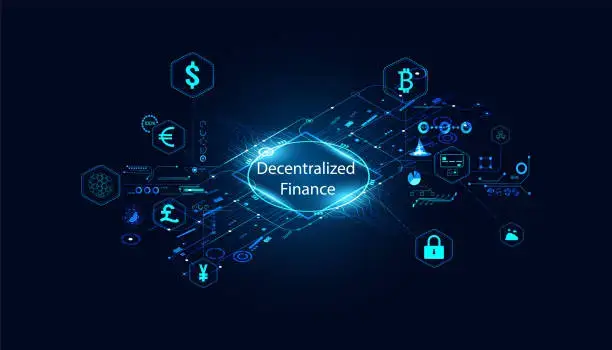DeFi, a new financial services paradigm has emerged in recent years.
It is set to disrupt traditional lending practices.
Decentralized finance (DeFi) is a financial ecosystem built on decentralized blockchain technology.
It aims to create an open, transparent, and accessible financial system.
DeFi operates on decentralization, trustlessness, and transparency principles.
It strives to provide financial services open to everyone.
DeFi leverages blockchain technology.
It allows anyone to access financial services without intermediaries like banks or financial institutions.
One of the most exciting growth areas within the DeFi ecosystem is crypto lending.
Crypto lending is the practice of lending and borrowing digital assets such as Bitcoin, Ethereum, and other cryptocurrencies.
Individuals and businesses can access funds through DeFi without traditional lending institutions.
It offers a new way for investors to earn returns on assets.
The rise of crypto lending reflects a broader trend in DeFi.
This trend focuses on democratizing financial services.
With DeFi, anyone can access financial services, regardless of their location, income level, or credit score.
Innovative Tech Solutions, Tailored for You
Our leading tech firm crafts custom software, web & mobile apps, designed with your unique needs in mind. Elevate your business with cutting-edge solutions no one else can offer.
Start NowThis shift marks a significant departure from traditional lending.
Large financial institutions have long dominated traditional lending, often with high entry barriers.
In this article, we will explore the rise of crypto lending and how it is changing traditional lending practices.
We will also look at the challenges and opportunities for the future of DEFI and crypto lending.
What is Crypto Lending and How is Different From Traditional Lending?
Crypto lending is a relatively new financial practice that involves the lending and borrowing of digital assets such as cryptocurrencies.
Crypto lending functions similarly to traditional lending.
Borrowers receive funds and agree to repay with interest over a specified period.
However, unlike traditional lending, which banks often facilitate, crypto lending is decentralized and relies on blockchain technology to facilitate transactions.
One of the main differences between traditional and crypto lending is the types of assets used as collateral.
In traditional lending, borrowers typically use physical assets, such as real estate or stocks, as collateral for their loans.
In contrast, in crypto lending, borrowers use digital assets, such as Bitcoin or Ethereum, as collateral.
Loan-to-value ratios in crypto lending can be much higher than in traditional lending.
Digital assets can be easily and instantly transferred between parties.
Another key difference between traditional lending and crypto lending is the level of transparency and control.
Traditional lending is often subject to a high degree of regulation and oversight.
This can limit the ability of borrowers and lenders to customize their agreements to meet their specific needs.
In contrast, crypto lending is entirely decentralized, with no intermediaries involved.
This means that borrowers and lenders can negotiate their terms and conditions without interference from third parties.
Overall, crypto lending represents a new and exciting development in the financial industry.
It offers borrowers and lenders an innovative and decentralized way to access funds and earn returns on their assets.
Although still evolving, crypto lending can disrupt traditional lending.
It may transform our understanding of financial services.
Read: All You Need To Know About Cryptocurrency

Benefits of Crypto Lending
Cryptocurrency lending offers several benefits over traditional lending practices, making it an attractive option for borrowers and lenders.
Seamless API Connectivity for Next-Level Integration
Unlock limitless possibilities by connecting your systems with a custom API built to perform flawlessly. Stand apart with our solutions that others simply can’t offer.
Get StartedOne of the main advantages of crypto lending is its accessibility.
Unlike traditional lending, crypto lending is available to anyone with digital assets as collateral.
Credit scores or significant collateral are not required.
Individuals previously excluded from traditional lending can now access funds through crypto lending.
This access enables them to grow their businesses or achieve personal goals.
Another key advantage of crypto lending is its speed and efficiency.
Traditional lending can be slow and cumbersome, involving multiple intermediaries and lengthy approval processes.
In contrast, crypto lending is entirely decentralized, with transactions occurring on a blockchain network in near real-time.
This means that borrowers can access funds quickly and easily without waiting for lengthy approval processes.
Crypto lending also offers greater transparency and control than traditional lending.
Traditional lending often subjects borrowers to complex terms.
These terms are difficult to understand, leaving borrowers with little control.
In contrast, crypto lending empowers borrowers and lenders to negotiate their terms.
The entire process is transparent and controlled by the participants.
As the crypto lending market evolves, it will likely play a more significant role in the global financial system.
Read: Centralized Vs Decentralized Finance Applications
Risks of Crypto Lending
While crypto lending offers many potential benefits, knowing the risks involved in this new and rapidly evolving market is important.
Some of the main risks associated with crypto lending include:
- Volatility risk: Digital assets, such as Bitcoin and Ethereum, are known for their high volatility. This means that the value of the assets used as collateral can fluctuate rapidly and unpredictably, which can create significant risks for both borrowers and lenders.
- Smart contract risk: Crypto lending relies on smart contracts to execute transactions on the blockchain. While smart contracts are designed to be self-executing and tamper-proof, they can still be subject to bugs and vulnerabilities that bad actors can exploit.
- Counterparty risk: Unlike traditional lending, which banks or other financial institutions often facilitate, crypto lending is entirely decentralized, with no intermediaries involved in the transaction. This means that borrowers and lenders are exposed to counterparty risk, meaning the risk that the other party will not fulfill their obligations under the agreement.
- Regulation risk: Crypto lending is a relatively new and rapidly evolving market, and it is subject to a patchwork of regulatory frameworks around the world. This means that the regulatory landscape can be uncertain and subject to sudden changes, which can create significant risks for market participants.
- Security risk: Digital assets are stored in digital wallets, which can be subject to hacking and cyberattacks. This means that the assets used as collateral can be vulnerable to theft or loss, which can create significant risks for both borrowers and lenders.
By understanding the risks involved and taking appropriate measures to manage them, investors and borrowers can participate in this exciting new market with greater confidence and security.
Read: The Benefits of Diversifying Your Cryptocurrency Portfolio
The Growth of Crypto Lending
Crypto lending has grown rapidly in recent years.
This growth is driven by the popularity of decentralized finance (DeFi) and blockchain technology adoption.
A report by Chainalysis revealed that in Q2 2021, outstanding cryptocurrency loans reached a record $14.2 billion.
This represents a 6-fold increase from the same period in the previous year.
Transform Business with Custom CRM & ERP Solutions
Elevate your operations with a CRM or ERP tailored for you. Let’s build the perfect solution that others can't replicate—crafted to match your business's needs like no other.
Get StartedDeFi has been a key driver of this growth.
It allows borrowers and lenders to interact directly, without intermediaries.
This direct interaction has reduced costs and increased transparency.
As a result, lending has become more accessible to a broader range of investors and borrowers.
In addition, the growth of crypto lending has been fueled by the increasing demand for yield among investors.
With traditional savings accounts offering low interest rates, many investors seek higher returns through crypto lending.
Crypto lending platforms offer a wide range of lending options, from short-term loans to longer-term investments.
This allows investors to tailor their portfolios to their individual needs and risk preferences.
Another factor driving the growth of crypto lending is the increasing adoption of digital assets as collateral.
Investors holding digital assets like Bitcoin and Ethereum want to use these assets.
Crypto lending offers a way to access funds and earn returns.
By using digital assets as collateral, crypto lending provides a new method for accessing liquidity.
As the market matures, crypto lending will likely become a crucial part of the global financial system.
It offers investors and borrowers new opportunities to access funds and earn returns.
Read: Blockchain Solutions: Revolutionizing Supply Chain Management
How is DeFi Changing Traditional Lending Practices?
Decentralized finance (DeFi) is revolutionizing traditional lending practices by providing a more transparent, accessible, and secure way for borrowers and lenders to interact with each other.
DeFi platforms operate on blockchain technology, which allows for the creation of self-executing and transparent smart contracts.
This means that the terms of the contract are clearly defined, and the transactions are recorded on a public ledger.
One of the most significant ways in which DeFi is changing traditional lending practices is by removing the need for intermediaries such as banks and other financial institutions.
Instead, borrowers and lenders can interact with each other directly on DeFi platforms.
This reduces costs and increases transparency in the lending process.
Additionally, this makes lending more accessible to a wider range of investors and borrowers, particularly those who have been historically underserved by traditional financial institutions.
Another key way in which DeFi is changing traditional lending practices is by providing more flexibility and control for borrowers and lenders.
DeFi platforms offer a wide range of lending options, from short-term loans to longer-term investments, and allow borrowers to customize the terms of their loans to meet their individual needs and risk preferences.
Tailored Tech Solutions to Drive Your Business Forward
Maximize your business potential with custom tech strategies. We deliver bespoke solutions that others can’t match, designed to solve your specific challenges with precision and impact.
Contact UsThis provides greater flexibility and control for borrowers, who can access funds on their own terms without being subject to the constraints of traditional lending practices.
In addition, DeFi is also changing the way collateral is used in lending.
Digital assets such as Bitcoin and Ethereum can be used as collateral on DeFi platforms, which provides a new and innovative way for borrowers to access funds and earn returns on their assets.
This has the potential to expand the pool of collateral available for lending, which can increase the market’s overall liquidity.
As this technology evolves, it is on the brink of a revolution.

The Future of Crypto and DeFi
The future of crypto lending and decentralized finance (DeFi) is promising, as the technology continues to evolve and mature, providing new opportunities for investors and borrowers.
As the crypto lending market grows, it is likely to become an increasingly important part of the global financial system, offering a wide range of benefits and opportunities to those who participate in it.
One of the most exciting aspects of the future of crypto lending and DeFi is the potential for increased adoption and acceptance.
As more investors and borrowers become familiar with the benefits of these technologies, adoption will likely continue to grow, leading to increased liquidity and greater innovation in the market.
In addition, the future of crypto lending and DeFi is likely to be characterized by increased regulation and oversight.
As the market matures and becomes more mainstream, regulators will likely examine these technologies more closely to provide increased protection for investors and borrowers.
Another key trend that is likely to shape the future of crypto lending and DeFi is the increasing use of automation and artificial intelligence.
As these technologies continue to evolve, they are likely to play an increasingly important role in the lending process, providing greater efficiency, accuracy, and security for borrowers and lenders alike.
Finally, the future of crypto lending and DeFi is likely to be characterized by continued innovation and the development of new products and services.
As the market grows and matures, new players are likely to emerge, offering a wide range of innovative solutions to meet the needs of investors and borrowers.
To sum it up, the future of crypto lending and DeFi is promising, with a range of benefits and opportunities for those who participate in the market.
Conclusion
The truth is that the rise of crypto lending and DeFi is an exciting development in the world of finance.
It provides new opportunities for investors and borrowers to access funds and earn returns on their assets.
As the market continues to evolve, it will be important for individuals and organizations to stay informed about the risks and benefits of these technologies to take advantage of the opportunities they present.
Before you go…
Hey, thank you for reading this blog to the end. I hope it was helpful. Let me tell you a little bit about Nicholas Idoko Technologies.
We help businesses and companies build an online presence by developing web, mobile, desktop, and blockchain applications.
We also help aspiring software developers and programmers learn the skills they need to have a successful career.
Take your first step to becoming a programming boss by joining our Learn To Code academy today!
Be sure to contact us if you need more information or have any questions! We are readily available.










